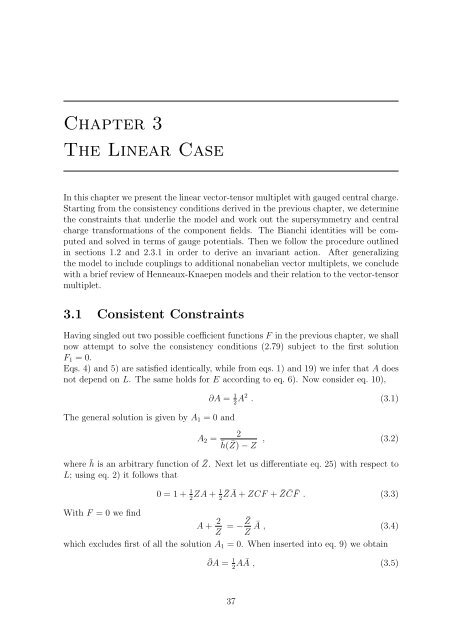N=2 Supersymmetric Gauge Theories with Nonpolynomial Interactions
N=2 Supersymmetric Gauge Theories with Nonpolynomial Interactions
N=2 Supersymmetric Gauge Theories with Nonpolynomial Interactions
You also want an ePaper? Increase the reach of your titles
YUMPU automatically turns print PDFs into web optimized ePapers that Google loves.
Chapter 3<br />
The Linear Case<br />
In this chapter we present the linear vector-tensor multiplet <strong>with</strong> gauged central charge.<br />
Starting from the consistency conditions derived in the previous chapter, we determine<br />
the constraints that underlie the model and work out the supersymmetry and central<br />
charge transformations of the component fields. The Bianchi identities will be computed<br />
and solved in terms of gauge potentials. Then we follow the procedure outlined<br />
in sections 1.2 and 2.3.1 in order to derive an invariant action. After generalizing<br />
the model to include couplings to additional nonabelian vector multiplets, we conclude<br />
<strong>with</strong> a brief review of Henneaux-Knaepen models and their relation to the vector-tensor<br />
multiplet.<br />
3.1 Consistent Constraints<br />
Having singled out two possible coefficient functions F in the previous chapter, we shall<br />
now attempt to solve the consistency conditions (2.79) subject to the first solution<br />
F1 = 0.<br />
Eqs. 4) and 5) are satisfied identically, while from eqs. 1) and 19) we infer that A does<br />
not depend on L. The same holds for E according to eq. 6). Now consider eq. 10),<br />
The general solution is given by A1 = 0 and<br />
A2 =<br />
∂A = 1<br />
2 A2 . (3.1)<br />
2<br />
¯h( ¯ Z) − Z<br />
, (3.2)<br />
where ¯ h is an arbitrary function of ¯ Z. Next let us differentiate eq. 25) <strong>with</strong> respect to<br />
L; using eq. 2) it follows that<br />
0 = 1 + 1 1 ZA + 2 2 ¯ ZĀ + ZCF + ¯ Z ¯ C ¯ F . (3.3)<br />
With F = 0 we find<br />
A + 2<br />
Z = − ¯ Z<br />
Ā ,<br />
Z<br />
(3.4)<br />
which excludes first of all the solution A1 = 0. When inserted into eq. 9) we obtain<br />
¯∂A = 1AĀ<br />
, (3.5)<br />
2<br />
37

















